
Source: (Gaete, 2012)
Identification of Stakeholders and conflicts of interest in the Ecuador Savings and credit Cooperatives
(*) Aníbal Altamirano Salazar
Administrative Sciences
University of the Armed Forces ESPE
Pichincha, Ecuador
waaltamirano@espe.edu.ec
Reception Date: 04/18/2018 - Approval Date: 05/15/2018
ABSTRACT
In the Savings and Credit Cooperatives management is different from the traditional approach, its administration is complicated by the democratic participation of the partners in the government of it and in the decision making. This aspect generates a special agency relationship because the partners who are owners can be both professional managers and workers. This situation causes conflicts of interest that generate risks and affect institutional performance. In this context, this research seeks to determine the stakeholders in the cooperatives and analyze their main conflicts of interest. For this purpose, an exploratory research was carried out using the methodology proposed by Gorrochategui, Casali, Frecia and Gigante, as an instrument for data collection to characterize and obtain the relationships among the stakeholders. Subsequently, in a sample of 58 cooperatives, as indicated by Mitchell, Agle and Wood, stakeholders were identified and classified according to attributes, power, legitimacy and urgency. Based on the above, it was determined that the model is applicable, as it allowed identifying and classifying according to its degree of preponderance to nine generic stakeholders and confirming the proposal made in this research.
KEY WORDS: Stakeholder; Conflict of Interest; Savings and Credit Cooperatives.
INTRODUCTION
The administration in the Savings and Credit Cooperatives has a special feature, as it manages resources of a conglomerate of people who become partners. By acquiring this status, they can democratically participate in their government and in decision-making, causing a special agency relationship to be generated. This situation arises because the partners who are owners, can be both professional managers, that is, be part of an administrative board, and also workers. On the other hand, the partners can offer goods and services to the cooperatives becoming suppliers of it, entering into competition with the external suppliers.
Among other stakeholders, there are people who, without needing to acquire the status of partners, use cooperative services, which are called clients, and their demand increases due to the high competition in this sector. The Cooperatives are organizations that provide services related to financial intermediation, their activity is regulated by several control organisms, which periodically request information and make revisions about the management carried out. Without leaving aside the community that expects the cooperatives to repay their results in plans of communal benefits that contribute to development.
As can be seen, there are several stakeholders with different interests, and their actions could cause conflicts of interest, generating risks that affect the institutional performance. In this context, it is necessary to determine who are the most important stakeholders, in whom are or who should be given more emphasis, without detracting from others. Although it is true, it is difficult to carry out an analysis of the stakeholders of each of the cooperatives, since the specific ones will vary, however, an analysis of the most general ones that arise in this sector can be carried out.
For this purpose, Freeman (1994) created the principle of who or what really counts? Donaldson & Preston (1995) define stakeholders as any actor that has a relationship or interests with the organization. However, stakeholders must be identified and classified, Mitchell, Agle and Wood (1997), propose a stakeholder identification model, which establishes its preponderance (salience) based on the simultaneous presence of three attributes; power, legitimacy and urgency.
In this context, the present research seeks to identify the stakeholders of savings and credit cooperatives and analyze their main conflicts of interest. In order to achieve this objective, the first part of the work points out the theoretical framework based on stakeholder theory and conflicts of interest, including its legal basis. In the second section, the methodology used is established.
In the third section, the results are divided into two parts; first where the reference organizations are established, the characterization of the stakeholders and the relationship of the organization with them. Later in the second part the stakeholders are determined based on the application of the Mitchell, Agle and Wood model. Finally, the conclusions are presented.
DEVELOPMENT
Stakeholder theory
In 1963, at Stanford University in the United States, the term stakeholders was mentioned for the first time in a memorandum, which explained those groups without which the company could stop functioning (Tolotti, 2008). However, since Freeman (1994) in his book Strategic Management a Stakeholder Approach, developed the theory of stakeholders, this concept was positioned in the minds of managers, creating the principle of who or what really counts? From this moment, multiple definitions of stakeholders appeared, Donaldson & Preston (1995), for example, define stakeholders as any actor that has a relationship or interests with the organization. In contrast, Bowie (1988); Freeman and Reed (1983) and Nasi (1995), refer to the stakeholders in terms of their need for the survival of the company.
Some authors have classified stakeholders from several points of view; Clarkson (1994) classifies them as voluntary and involuntary. Volunteers have some kind of risk for having invested their human or financial capital in a company, and the involuntary ones put themselves in risk as a result of the activities of the company. On the other hand, Freeman, Harrison and Wicks (2007), classify the stakeholders in primary and secondary; the primary ones are those which the company could not continue to operate in the market (González C., 2010). On the other hand, the secondary ones are not directly related to the economic activities of the organization, but they can exercise a type of influence or they can be affected by it (Roitstein, 2004).
Mitchell, Agle and Wood (1997), propose a stakeholder identification model, which establishes its preponderance (salience) based on the simultaneous presence of certain attributes in actors that affect or are affected by the objectives or results of an organization. In this regard Falcao and Fontes (1999) establish that stakeholders are actors that affect or are affected by the objectives and results of an organization, to the extent that they possess one or any of the three attributes, called power, legitimacy and urgency. According to this model, the actors that do not affect the results and / or that are not affected by the results, are not stakeholders.
In addition, Falcao and Fontes (1999) point out who should focus on? and therefore the priority that the manager assigns to the stakeholders will depend on the attributes that they possess. It should be noted that this model allows to relate the objective of the organization with the demands of the most important stakeholders. In table N°1, the classification of the Stakeholders can be visualized according to the attributes that it possesses:
Table N° 1. Category, attributes and types of stakeholders

Source: (Gaete, 2012)
Conflict of Interest
In relation to the term conflict of interest, some authors have tried to define it, Terry (1982) and OECD (2003) agree that it is a confrontation between the public duty and the private interests of the functionary causing a collision with the duties and obligations of his position. The proper handling of conflicts of interest aims to take care of the independence of criteria and the principle of equity that officials must maintain (Zin, 1986).
In this context, International Transparency organization defines it as:
“Situation in which an individual or the entity for which he works, whether a government, a company, a means of communication or a civil society organization, faces a choice between the duties and demands of his position and his own private interests”. (International Transparency, 2018, p. s/p).
The regulatory system of Ecuador establishes in which situations conflicts of interest can occur, the Organic Financial Code points out three fundamental aspects, which are detailed below:
a) When officials and members of the entities of regulation or control of the national financial system and insurance and securities regimes have interests of a patrimonial nature in the areas to be regulated, supervised or controlled, or represent and advise third parties.
b) The conflict of interest of a patrimonial nature will be configured by the ownership of 1% or more of the subscribed and paid capital of the regulated or controlled entity or the equivalent of one thousand unified basic salaries, whichever is greater. In this case, the member, official or servant of the regulatory and control bodies must discard the titles that give rise to the conflict of interests of a patrimonial nature. If any official owns shares in any of the regulated or controlled entities for an amount lower than the amount determined, he/she is obliged to make the fact known in writing to his nominating authority. Similarly, will inform if he/she had a spouse or relative within the third degree of consanguinity or second of affinity, or father or adopted child, who are working in those entities.
c) Those who have a relationship of kinship within the fourth degree of consanguinity and second of affinity with persons with equity property with influence and with administrators of the private and popular and solidarity financial institutions, insurance are found to be in conflict of interest. And private securities, within the scope of their respective competence (Organic Monetary and Financial Code, 2014).
On the other hand, the Organic Law of Popular and Solidarity Economy and its Regulations establish certain norms that seek to prevent conflicts of interest. The members of the cooperatives may not make undue use of the public resources they receive, considering as public resources those received by the cooperatives of their associates. The use of the organization is also prohibited, with the purpose of tax evasion or evasion for the benefit of its partners or third parties. To complement, credit quotas have been set for the members of the councils, management and employees, their spouses and relatives within the fourth degree of consanguinity and second of affinity (Popular and Solidarity Economy Law, 2011).
Methodology
The present work is exploratory in nature, as it seeks to internalize some characteristics of the stakeholders of the savings and credit cooperatives of Ecuador, as well as the nature and type of interactions that occur between them. For this purpose, secondary sources were used, such as institutional websites, sustainability reports and public documents produced by the cooperatives. As an instrument for data collection, the methodology proposed by Gorrochategui, Casali, Frecia and Gigante (2013) was used to characterize and obtain relationships among stakeholders. Later, what was pointed out by Mitchell, Agle and Wood (1997), which proposes a typology of stakeholders, taking into account three factors called Power, Legitimacy and Urgency.
According to the cadastre of the Superintendency of Popular and Solidarity Economy there are 671 active cooperatives, classified into five segments according to the level of their total assets. However, for the development of this work the cooperatives of segments 1, 2 and 3 were taken into account, since, the three segments represent 87.65% in relation to the total assets, defining a universe of 148. For the calculation of the sample, the formula of the simple estimation method was used for the Irrestricted Random Sampling (Calero, 2003). The defined parameters were: Population (N) 148 cooperatives, level of significance (α) 0.05, error (d) 0.10, Probability value (P) 0.5, obtaining as a result 58 cooperative.
Once the sample was established, the number of cooperatives was determined by segment, for which the sampling formula was applied by proportional allocation (Calero, 2003). Obtaining as result 11 cooperatives for segment one, 15 for segment two and 32 for segment three. To guarantee the random selection of the sample, the table of random numbers was used (Kendall & Babington, 1939).
Reference Organization
For the development of the present investigation, the savings and credit cooperatives of Ecuador were considered, as they have a special particularity in their administration and importance in the economic and social development of the country. First, they are democratically controlled jointly owned companies (ACI International Cooperative Alliance, 2017). This democratic control allows the partners to participate in the government of the same and in decision-making. Characteristics, which cause a special agency relationship, which encourage the emergence of new stakeholders, compared to companies where capital is the priority (Altamirano, Pazmiño, Espinoza, & Cerda, 2016).
In Ecuador, according to the cadastre carried out by the Superintendency of Popular and Solidarity Economy, as of November 2017, there are 671 active savings and credit cooperatives. The same ones that have been classified into five segments according to the level of their total assets, as established in table N° 2.
Table N° 2. Reference Organizations
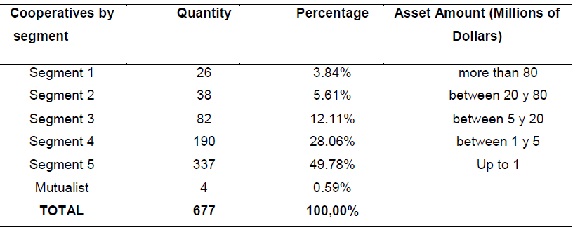
Source: Own Elaboration
As explained above, the cooperatives of segments 1, 2 and 3 will be taken into account, defining a universe of 148 cooperatives that represent 22.05% of the total. This percentage is established only by the number of cooperatives, without representing their participation in the market. The selected segments represent the largest cooperatives in the country, both in terms of resources and partners. As defined in the methodology, the sample selected is 58 cooperatives.
Identification of the Stakeholders
It is difficult to carry out an analysis of the stakeholders of each one of the cooperatives, since the specific stakeholders will vary, for this reason an analysis of the most general ones that arise in this sector was carried out. Figure No. 1 identifies the generic stakeholders of a savings and credit cooperative.
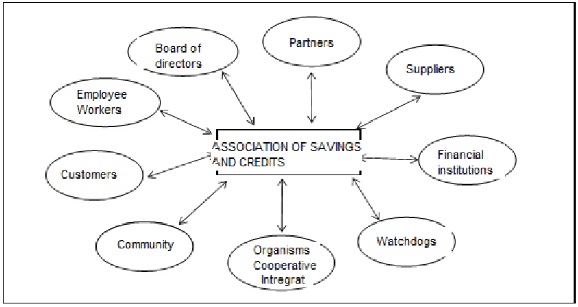
Figure N° 1. Identification of Stakeholders
Source: Own elaboration from Donalson and Preston (1995)
Type of Stakeholder
In the previous figure, the stakeholders of a cooperative were identified without classifying them around any criterion, Guerras and Navas (2007) classified the stakeholders in internal and external. Table No. 3 discriminates stakeholders by type and category.
Table N° 3. Type of Stakeholders

Source: Own Elaboration
External stakeholders represent 66.67% and are made up of suppliers, customers, financial institutions, community, control organisms and cooperative integration organizations. It is vitally important to reconcile the interests of these groups, in this way it achieves credibility, greater transparency and good image of the organization. On the other hand, the internal stakeholders integrated by the partners, management councils and the employees or workers represent 33.33%, which provide the organizational identity to the extent that they see their expectations in the cooperative (Scott & Lane, 2000).
Importance attributed by the organization to the Stakeholders
In this section, the importance of cooperatives to their stakeholders according to the levels at which they make the mention will be mentioned. Gorrochategui, Casali, Frecia and Gigante (2013) establish three levels: Strategic Level, Social Responsibility and Others, as detailed in table No. 4.
Table N° 4. Importance attributed to the stakeholder
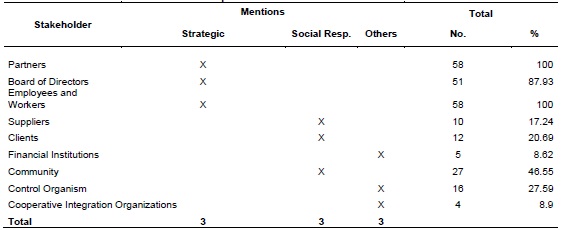
Source: Own Elaboration
The above table explains the behavior of the 58 cooperatives analyzed, as evidenced, the stakeholders most mentioned by 100% of the sample are the Members, Employees and Workers, while the Board of Directors was mentioned by 87.93%. It is important to point out that these mentions are found at the strategic level, that is, in their vision, mission, objectives and strategies. With respect to the mentions made in the sustainability and social responsibility reports, the community stakeholders are mentioned by 27 cooperatives that represent 46.55%. Customers and suppliers are mentioned by 20.69% and 17.24% respectively. The least-mentioned stakeholders are financial institutions and cooperative integration agencies, at 8.62% and 6.90% respectively, information that was found in documents such as work plans and budgets.
Objectives of the organization with respect to the Stakeholder
In order to establish an application guide, five categories were selected, based on the objectives pursued by the cooperatives in reference to their stakeholders. According to the analysis of the mentions in the strategic plans, sustainability reports, progress reports and other documents, the following results were obtained and presented in table No. 5.
Table N° 5. Objectives of the organization regarding the stakeholder
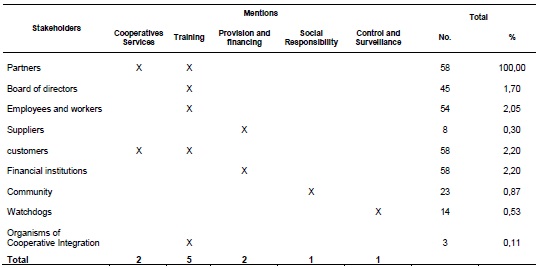
Source: Own Elaboration
In the analyzed sample, it was determined that 100% of the cooperatives establish as their primary objective to provide adequate cooperative services to their partners and clients, with their respective training. The same percentage establishes that the objective of obtaining adequate financing is carried out through financial institutions. Another of the objectives is to provide training and professional training to its employees and workers, which also deserves the attention of cooperatives in 93.10%.
With regard to the Board of Directors, 77.59% of the cooperatives have established as objective to train their members. 39.66% establish objectives that are related to social responsibility projects in favor of the communities that surround the cooperatives. With regard to the objectives related to suppliers, control bodies and cooperative integration, a small percentage of cooperatives have considered them in their documents.
Proposition No.1.- Efficiency and effectiveness in cooperative services, training and the search for financing are the main objectives of the organization in relation to its stakeholders.
Objectives of the stakeholder with respect to the Organization
To determine the objectives of the partners and clients, the satisfaction surveys carried out by the cooperatives of the selected sample were reviewed. The result obtained establishes that its main objective is to obtain a wide range of financial services. Among the most desired services are the immediate credits at low cost, high passive rates on the investments that the associates make and complementary financial services, ATMs interconnected to the banking network.
However, as mentioned above, in Savings and Credit Cooperatives the management is different from the traditional approach, its administration is complicated by the democratic participation of the partners in the government of the same and in decision-making. Therefore, the partners who are owners can be both professional managers and workers, they can also participate in the general assemblies, elect and be elected members of the Boards of Administration and Surveillance or occupy representative positions.
This situation implies the existence of several parties with different objectives and interests, causing conflicts of interest ranging from the conception of not losing control of the administration to the concealment of a fraud. Aspects that encourage the use of creative practices that distort information.
Regarding the objectives of the Employees and Workers, the work climate surveys served to establish their main aspirations, among which, the economic and labor recognition, training, stability and the career plan stand out. The cooperative integration organization represented by the National Federation of Savings and Credit Cooperatives (FECOAC) has defined as its main objective the grouping of the largest number of cooperatives in order to provide advice and representation.
The stakeholder that puts more emphasis on its objectives in reference to cooperatives, is related to the control agencies, represented basically by the Superintendence of Popular and Solidarity Economy. On its website, it aims to provide the administrative, legal and technical framework for the development of the cooperative sector. It also establishes the control and inspection parameters to ensure that the resources of the cooperatives are managed efficiently.
Types of responsibility of the organization by the stakeholder
After the analysis made in the selected sample, it was determined that the primary responsibility falls on six stakeholders, the secondary one on three and finally the tertiary on one as detailed in table No. 6.
Table N° 6. Types of responsibility of the organization by the stakeholder
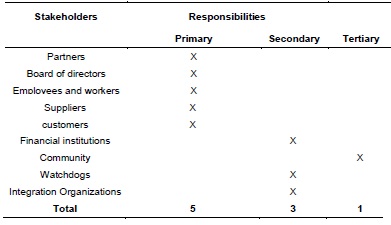
Source: Own Elaboration
Cooperatives in relation to partner stakeholders, board of directors, employees, suppliers and customers have a primary responsibility, since the impact of their main activity is to say the provision of financial services can be translated into legal, financial and / or operational actions. In contrast, with stakeholders financial institutions, control bodies and cooperative integration that are interdependent groups with which no non-contractual relationships are established, a secondary responsibility is maintained. In turn, tertiary responsibility is manifested in the stakeholder community, because its impact has to do with aspects of the social environment.
Dependence of the organization with respect to the stakeholder
The dependency variable of the organization allows establishing a typology of stakeholders, depending on their degree of dependence (Gorrochategui, Casali, Frecia, & Gigante, 2013). As can be seen in Table No. 7, in the case of cooperatives, the partners, customers, board of directors and control bodies establish a type of stakeholders that are considered irreplaceable. Employees and financial institutions make up a typology called Reciprocal, and finally the suppliers, community and integration organizations are stakeholders of the non-contact type.
Table N° 7. Dependence of the organization with respect to the stakeholder
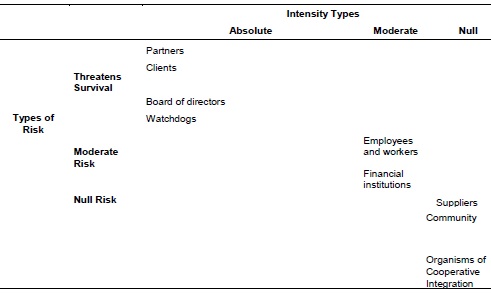
Source: Own Elaboration
Proposition No. 2.- In credit unions, the partners, clients, board of directors and the control organisms mean a threat to the survival of the cooperatives with a level of absolute intensity, due to the diversity of interests.
In 2014, in a study carried out by the Superintendency of Popular and Solidarity Economy, 62 cooperatives entered into processes of problem solving in which to date, according to this agency, more than five thousand strategies have been proposed to reduce their levels of risk. These risks are related to the diversity of interests that exists in the members and clients of the cooperatives, which range from obtaining loans at low costs and investments with attractive passive rates, until they can become part of the cooperative's administration, in the case of partners. When they become members of a board of directors of the cooperative, a special agency relationship is generated, as new interests arise that generate conflicts, ranging from the conception of power, to the concealment of a fraud, through the use of creative practices in accounting.
In this context and to reaffirm the proposal, some events that have occurred in Ecuador are mentioned, related to financial scandals caused by unexpected closures of cooperatives. The most recent case is presented in 2015 in the cooperative of savings and credit Coopera, the judicial authorities issued a ruling for embezzlement and money laundering in the amount of 7.1 million dollars, until this date the cooperative owes 30.1 million dollars to 639 members. An audit conducted by the Superintendency of Popular and Solidarity Economy revealed that the causes were the overvaluation of assets to hide losses, distraction of depositors' resources and the issuance of credits without support to different partners.
Another cooperative that closed its doors unexpectedly was the CAPTEC Tungurahua cooperative, after a process of supervision by the control body that determined the existence of credits linked to two managers for more than 1.5 million dollars. Additionally, the Cooperative granted loans without any supporting documents such as invoices, promissory notes or bills of exchange for an amount of 6 million dollars. These loans represented 39% of the total loan portfolio and most of it was given to five partners, including the Chairman of the Board of Directors. Another important aspect of this report is the sale of five undervalued homes, of which two were sold in January 2013 to the Chairman of the Board of Directors (Superintendence of Popular and Solidarity Economy, 2015).
In reality, of the 62 cooperatives that entered into problem-solving processes, 10 have been liquidated and 56 files were sent to the prosecutor's office for the investigation of alleged crimes such as fraud, money laundering, embezzlement, among others. The aforementioned facts were made by partners who were part of the boards of directors, for their own benefit and that of third parties, demonstrating that they are an absolute threat to the survival of a cooperative. Added to all this lack of control by the relevant agencies, have allowed the origin of some fraudulent acts that have led to the bankruptcy and liquidation of some cooperatives.
Application of the Mitchell, Agle and Wood model
For the identification of the stakeholders, the methodology established in the research of Falcao and Fontes (1999) was used, which observes the perspective proposed by Mitchell, Agle and Wood (1997). The same that is in function of the preponderance and of the simultaneous presence of certain attributes in the actors, denominated power, legitimacy and urgency.
Power
It is the capacity that the stakeholder has to influence in the organization, in such a way that it would not have done it in another way (Gorrochategui, Casali, Frecia, & Gigante, 2013). For the present work, the degree of power was established based on the sensitivity and availability of power resources (coercive, utilitarian and symbolic) in each identified actor. To determine the degree of sensitivity a scale of 0 to 3 was used, where 0 means that there is no sensitivity with respect to the resource and 3 extreme sensitivity. In the same way it was done for the degree of availability, 0 means that the actor does not possess the resource in question and 3 that he has it in a maximum magnitude of influence.
To determine the degree of power of the actor, the degree of sensitivity to the resource was multiplied by the degree of availability of the actor for it. Later to determine the degree of total power of the actors, we proceeded to multiply all the degrees of power obtained in the different s resources. Table No. 8 shows the results obtained.
Table N° 8. Power Matrix
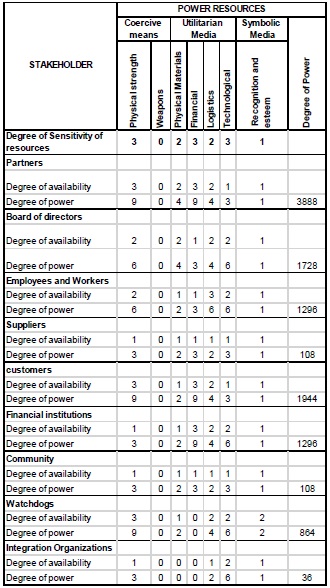
Source: Own Elaboration, based on the Mitchell, Agle and Wood model, published in Falcao Humberto and Fontes Joaquin (1999)
The partners that detect the greatest degree of power are the partners, because they have greater resources of power in relation to the vulnerabilities and needs of the cooperatives, mainly based on physical strength and financial resources. Clients occupy the second place followed by the board of directors, financial institutions, control bodies and employees and workers. The actor that has a lower degree of power are the integration organizations that limit themselves to offer technological resources.
Legitimacy
It is the generalized perception that the activities of an organization are desirable in the social environment within a normative and cultural framework (Gorrochategui, Casali, Frecia, & Gigante, 2013). In order to assess the degree of legitimacy, it was carried out according to the desirability seen from two perspectives, the organization and society. For both cases a scale of 0 to 3 was used, 0 means that the actions of the actor are perceived as undesirable and 3 as highly desirable. By multiplying the two factors, the degree of total desirability of the actors is obtained. The results are detailed in table No. 9.
Table N° 9. Matrix of Legitimacy
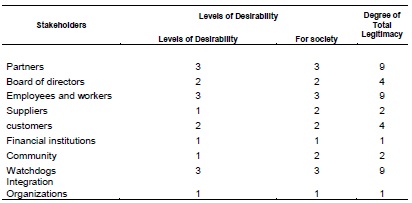
Source: Own Elaboration, based on the Mitchell, Agle and Wood model, published in Falcao Humberto and Fontes Joaquin (1999)
As a result of the study carried out, it was determined that the stakeholders, control organizations and employees and workers, have a high degree of organizational and social legitimacy. Understanding that they have the capacity to make a claim to the entity in contractual terms as well as to exercise the representation of people or sectoral or social interests. As for the board of directors and clients, they have an average organizational and social level. This means that they can make a complaint based on the expectations not met by the organization in a non-articulated manner, forming an ad hoc group for that purpose.
Urgency
In relation to the urgency, which is understood as the need for immediate attention to the expectations and demands of the stakeholders, it was determined based on the temporal sensitivity and criticality. In the same way, the same scale was used for the two variables, in the case of the time sensitivity 0 means total acceptance of the delay and 3 non-acceptance of the delay. For the criticality, it was marked with 0 the non-critical factors that do not imply losses and with 3 the highly critical factors that imply losses. Table No.10 presents the results.
Table N° 10. Emergency Matrix
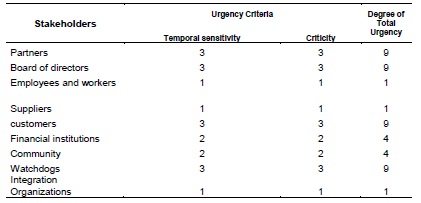
Source: Own Elaboration, based on the Mitchell, Agle and Wood model, published in Falcao Humberto and Fontes Joaquin (1999)
The stakeholders, board of directors, clients and control organizations have the highest urgency attribute, as their demands have a high degree of criticality and temporary sensitivity and are addressed immediately, a situation that does not occur for the other actors.
Identification of stakeholders (Consolidation Matrix)
For this purpose, the matrices of power, legitimacy and urgency were consolidated, in order to obtain the preponderance index. To obtain this index, the attributes were normalized in order to take them to the same base of comparison. The results obtained are detailed in table No. 11.
Table N° 11. Consolidation Matrix
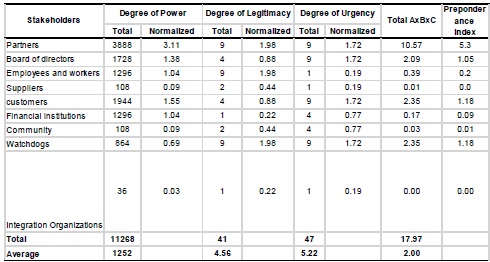
Source: Own Elaboration, based on the Mitchell, Agle and Wood model, published in Falcao Humberto and Fontes Joaquín (1999)
There are 5 actors that have obtained a preponderance index of less than 1, this result only means that it is below the average, but it does not stop being important for the cooperatives. In this sense, the main objective was to visualize those actors that have greater or lesser importance in a cooperative.
For this purpose, the stakeholder classification presented by Gorrochategui, Casali, Frecia and Gigante (2013) was used, which is detailed in table No. 12.
Table N° 12. Classification of stakeholders
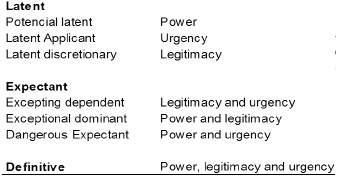
Source: self made
Tables No. 11 and No. 12 allow to classify the stakeholders based on the standardized results obtained by each one, for example, the partners have the three attributes of power 3.11, legitimacy 1.98 and urgency 1.72. He is considered as a definite stakeholder. The board of directors has two power attributes 1.38 and 1.72 urgency belonging to the dangerous expectant classification. In contrast, financial institutions have only one power attribute 1.04, obtaining the classification of potential latent. The stakeholders suppliers, community and cooperative integration organizations do not have any attributes, since their results do not exceed the value of 1 and are considered non-stakeholders according to this model. The final classification of all the actors is detailed in table No. 13.
Table No.13.- Results of the classification of the Stakeholders
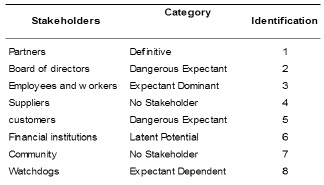
Source: self made
Graphic classification of the stakeholders
Mitchell, Agle and Wood (1997), plot the classification of stakeholders according to the relationship between the attributes of legitimacy and urgency and establish 7 stakeholder categories, as shown in Figure No. 2.
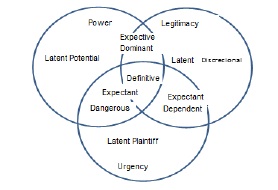
Figure N° 2. Graphic Classification of Stakeholders
Source: Model by Mitchell, Agle and Wood (1997, page 874)
Figure No.3 graphically represents the results obtained in the analysis and determination of the stakeholders of the savings and credit cooperatives of Ecuador.
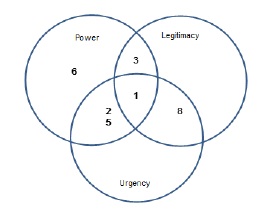
Figure N° 3. Classification of the stakeholders
Source: Own Elaboration, based on the Mitchell, Agle and Wood model (1997)
CONCLUSION
The present investigation demonstrates the existence of several generic stakeholders in a savings and credit cooperative in Ecuador, which, having been identified and then classified according to certain attributes, demonstrate their degree of preponderance, that is, where they should place the Cooperatives focus and to whom we give greater attention. The results show that the partners are the only stakeholder that possesses the three attributes, power, legitimacy and urgency, and therefore the cooperatives have put all their attention on them.
The model of Mitchel, Agle and Wood is applicable, since, by locating stakeholders, clients, board of directors and control bodies, as definitive stakeholders, dangerous expectants and dependent expectants, confirmed the proposal made in this investigation. Because these stakeholders pose a threat to the survival of cooperatives with a level of absolute intensity, because of their diversity of interests. In addition, the objective was fulfilled, which consisted in visualizing those actors that have greater or lesser importance in a cooperative, in order to classify them as latent, expectant and definitive.
With respect to conflicts of interest, it was determined that they originate due to the special particularity that exists in their administration, as it allows the partners to be and form stakeholders from different groups. Internally, the members are owners of the cooperative, they can be members of the administrative councils and also workers, depending on their level of knowledge and specialization. On the other hand, in the external environment they can become providers and representatives of social organizations representing the community.
The determination of the stakeholders is a new issue, which has not yet been put into practice by the credit unions of Ecuador. In this investigation, only their generic stakeholders were determined; however, cooperatives should establish specific stakeholders, applying the methodology used in this investigation.
BIBLIOGRAPHCIAL ABSTRACT
Please refer to articles Spanish Biographical abstract.
REFERENCES
Please refer to articles in Spanish Bibliography.